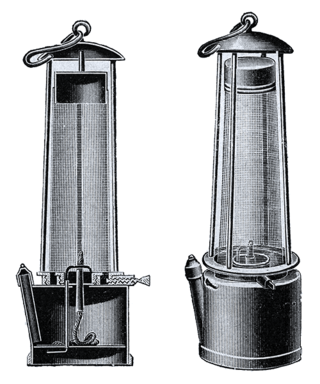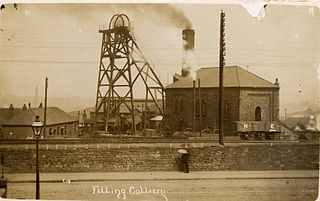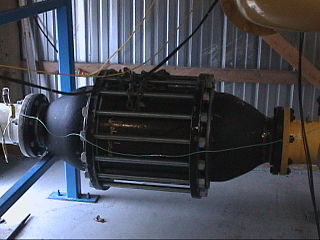This article needs additional citations for verification .(May 2007) |

The Geordie lamp was a safety lamp for use in flammable atmospheres, invented by George Stephenson in 1815 as a miner's lamp to prevent explosions due to firedamp in coal mines.
This article needs additional citations for verification .(May 2007) |

The Geordie lamp was a safety lamp for use in flammable atmospheres, invented by George Stephenson in 1815 as a miner's lamp to prevent explosions due to firedamp in coal mines.
In 1815, Stephenson was the engine-wright at the Killingworth Colliery in Northumberland and had been experimenting for several years with candles close to firedamp emissions in the mine. In August, he ordered an oil lamp, which was delivered on 21 October and tested by him in the mine in the presence of explosive gases. He improved this over several weeks with the addition of capillary tubes at the base so that it gave more light, and tried new versions on 4 and 30 November. This was presented to the Literary and Philosophical Society of Newcastle upon Tyne (Lit & Phil) on 5 December 1815. [1]
Although controversy arose between Stephenson's design and the Davy lamp (invented by Humphry Davy in the same year), Stephenson's original design worked on significantly different principles from Davy's final design. [2] If the lamp were sealed except for a restricted air ingress (and a suitably sized chimney) then the presence of dangerous amounts of firedamp in the incoming air would (by its combustion) reduce the oxygen concentration inside the lamp so much that the flame would be extinguished. Stephenson had convinced himself of the validity of this approach by his experiments with candles near lit blowers: as lit candles were placed upwind of the blower, the blower flame grew duller; with enough upwind candles, the blower flame went out. [3]
To guard against the possibility of a flame travelling back through the incoming gases (an explosive backblast), air ingress was by a number of small-bore tubes through which the ingress air flowed at a higher velocity than the velocity of a flame fueled by a mixture of firedamp (mostly methane) and air. These ingress tubes were physically separate from the exhaust chimney. The body of the lamp was lengthened to give the flame a greater convective draw, and thus allow a greater inlet flow restriction and make the lamp less sensitive to air currents. The lamp itself was surrounded by glass, which had an additional perforated metal tube surrounding it for protection. Davy had originally attempted a safety lamp on similar principles, before preferring to enclose the flame inside a brass gauze cylinder; he had publicly identified the importance of allowing the restricted airflow in through small orifices (in which the flame velocity is lower) before Stephenson had, and he and his adherents remained convinced that Stephenson had not made this discovery independently. [4] [lower-alpha 1] Later on, Stephenson adopted Davy's gauze to surround the lamp (instead of the perforated metal tube) and the intake tubes were changed to holes or a gallery at the base of the lamp. It was this revised design that was used for most of the 19th century as the Geordie lamp.
One advantage of Stephenson's initial design over Davy's was that if the proportion of firedamp became too high, his lamp would be extinguished, whereas Davy's lamp could become dangerously hot. This was illustrated in the Oaks colliery at Barnsley on 20 August 1857 where both types of lamp were in use. [7]
Stephenson's design also allowed better light output as it used glass to surround the flame, which cut out less of the light than Davy's, where the gauze surrounded it. [8] But this also posed the danger of breakage in the harsh conditions of mineworking, a problem which was not resolved until the invention of safety glass.
The Geordie lamp continued to be used in the north-east of England through most of the 19th century, until the introduction of electric lighting.[ citation needed ]



The Davy lamp is a safety lamp used in flammable atmospheres, invented in 1815 by Sir Humphry Davy. It consists of a wick lamp with the flame enclosed inside a mesh screen. It was created for use in coal mines, to reduce the danger of explosions due to the presence of methane and other flammable gases, called firedamp or minedamp.

George Stephenson was an English civil engineer and mechanical engineer during the Industrial Revolution. Renowned as the "Father of Railways", Stephenson was considered by the Victorians as a great example of diligent application and thirst for improvement. His chosen rail gauge, sometimes called "Stephenson gauge", was the basis for the 4-foot-8+1⁄2-inch (1.435 m) standard gauge used by most of the world's railways.

Sir Humphry Davy, 1st Baronet, was a British chemist and inventor who invented the Davy lamp and a very early form of arc lamp. He is also remembered for isolating, by using electricity, several elements for the first time: potassium and sodium in 1807 and calcium, strontium, barium, magnesium and boron the following year, as well as for discovering the elemental nature of chlorine and iodine. Davy also studied the forces involved in these separations, inventing the new field of electrochemistry. Davy is also credited to have been the first to discover clathrate hydrates in his lab.

Geordie is a nickname for a person from the Tyneside area of North East England and the dialect used by its inhabitants, also known in linguistics as Tyneside English or Newcastle English. There are different definitions of what constitutes a Geordie. The term is used and has been historically used to refer to the people of the North East. A Geordie can also specifically be a native of Tyneside and the surrounding areas. Not everyone from the North East of England identifies as a Geordie.

A kerosene lamp is a type of lighting device that uses kerosene as a fuel. Kerosene lamps have a wick or mantle as light source, protected by a glass chimney or globe; lamps may be used on a table, or hand-held lanterns may be used for portable lighting. Like oil lamps, they are useful for lighting without electricity, such as in regions without rural electrification, in electrified areas during power outages, at campsites, and on boats. There are three types of kerosene lamp: flat-wick, central-draft, and mantle lamp. Kerosene lanterns meant for portable use have a flat wick and are made in dead-flame, hot-blast, and cold-blast variants.

Tyneside is a built-up area across the banks of the River Tyne in Northern England. Residents of the area are commonly referred to as Geordies. The whole area is surrounded by the North East Green Belt.
Firedamp is any flammable gas found in coal mines, typically coalbed methane. It is particularly found in areas where the coal is bituminous. The gas accumulates in pockets in the coal and adjacent strata and when they are penetrated the release can trigger explosions. Historically, if such a pocket was highly pressurized, it was termed a "bag of foulness".
The Blantyre mining disaster, which happened on the morning of 22 October 1877, in Blantyre, Scotland, was Scotland's worst ever mining accident. Pits No. 2 and No. 3 of William Dixon's Blantyre Colliery were the site of an explosion which killed 207 miners, possibly more, with the youngest being a boy of 11. It was known that firedamp was present in the pit and it is likely that this was ignited by a naked flame. The accident left 92 widows and 250 fatherless children.
Trimdon Grange is a village in County Durham, in England. It is situated ten miles to the west of Hartlepool, and a short distance to the north of Trimdon.
A safety lamp is any of several types of lamp that provides illumination in places such as coal mines where the air may carry coal dust or a build-up of inflammable gases, which may explode if ignited, possibly by an electric spark. Until the development of effective electric lamps in the early 1900s, miners used flame lamps to provide illumination. Open flame lamps could ignite flammable gases which collected in mines, causing explosions; safety lamps were developed to enclose the flame to prevent it from igniting the explosive gases. Flame safety lamps have been replaced for lighting in mining with sealed explosion-proof electric lights, but continue to be used to detect gases.
William Reid Clanny FRSE was an Irish physician and inventor of a safety lamp.

The Felling Colliery in Britain, suffered four disasters in the 19th century, in 1812, 1813, 1821 and 1847. By far the worst of the four was the 1812 disaster which claimed 92 lives on 25 May 1812. The loss of life in the 1812 disaster was one of the motivators for the development of miners' safety lamps such as the Geordie lamp and the Davy lamp.
The Brandlings of Newcastle were a wealthy family of merchants and land and coal owners in Newcastle upon Tyne and Northumberland.
Industrial fans and blowers are machines whose primary function is to provide and accommodate a large flow of air or gas to various parts of a building or other structures. This is achieved by rotating a number of blades, connected to a hub and shaft, and driven by a motor or turbine. The flow rates of these mechanical fans range from approximately 200 cubic feet (5.7 m3) to 2,000,000 cubic feet (57,000 m3) per minute. A blower is another name for a fan that operates where the resistance to the flow is primarily on the downstream side of the fan.

A mining lamp is a lamp, developed for the rigid necessities of underground mining operations. Most often it is worn on a special safety helmet.

A flame arrester, deflagration arrester, or flame trap is a device or form of construction that will allow free passage of a gas or gaseous mixture but will interrupt or prevent the passage of flame. It prevents the transmission of flame through a flammable gas/air mixture by quenching the flame on the high surface area provided by an array of small passages through which the flame must pass. The emerging gases are cooled enough to prevent ignition on the protected side.
The West Stanley Pit disasters refers to two explosions at the West Stanley colliery. West Stanley colliery was a coal mine near Stanley, with the mine opening in 1832 and closing in 1936. Over the years several seams were worked through four shafts: Kettledrum pit, Lamp pit, Mary pit and New pit. In 1882 an underground explosion killed 13 men and in 1909 another explosion killed 168 men.
John Hodgson (1779–1845) was an English clergyman and antiquary, known as the county historian of Northumberland.

The Lundhill Colliery explosion was a coal mining accident which took place on 19 February 1857 in Wombwell, Yorkshire, UK in which 189 men and boys aged between 10 and 59 died. It is one of the biggest industrial disasters in the country's history and it was caused by a firedamp explosion. It was the first disaster to appear on the front page of the Illustrated London News.

Charles John Brandling was an English MP and coal owner.
Bibliography